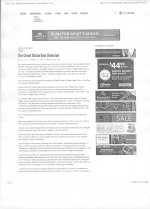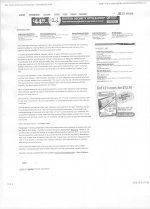If you got the actual person who was on a recorded show to come into their TV room, stand next to the set while that show was playing, would they swear that there is no difference, on the bible??
I don't care what the person on the show saw. I want to see what the director sent out. The director will have had a calibrated set of displays in the studio. If I calibrate my monitor then I have a baseline of the broadcast standard. Calibrating monitors/TVs is easy as there are calibration standards everyone (bar you) agree on. If I then want to adjust to taste for something, I can at least get back to a reference standard.
How do you know? You do not see their intent, assuming intent is what you mean by 'try'.
You are not in the group of 'most', that's how I know!
But in reality you just believe that the differences fall at or below the threshold of audibility.
It might be a plausible hypothesis, based on the known thresholds for single parameters, but in fact for complex stimuli diverging in a multitude of parameters there is no threshold known.
To be double blind is usually part of the scientific requirements but there is no need for using the ABX protocol. It is not that easy; a lot of tests are unfortunately methodologically flawed.
But the data/publication was all that was asked for. Exists hard evidence already or is it a hypothesis that should be tested?
Absolutely; we all tend to jump to conclusions.....
I do remember it; there was no sound controlled listening experiment involved at all.
When it comes to this stuff, I am more likely to believe professionals in that field than arm chair theorists who believe they are qualified to unravel the mysteries of the human mind because they can solder a resistor.
I mentioned the carver test - the GEB claimed they could pick out one amplifier from another. Bob Carver proved they could not even in an uncontrolled tests. So, under controlled tests most subjects fail, and when we have an uncontrolled test but with a basic level of 'no peaking allowed' they also fail . . .
Last edited:
My hypothesis is that its attention seeking John.
Because John, there is quite a bit of scientific data that says you cannot if you don't peek.
Example: raising speaker cables off the floor on Oregon maple would blocks in full view of the subject and claiming that it improves the sound.
Last edited:
Carver also proved that large quantities of xover distortion in amps was not audible.
Where and when did he do this?
No, the 'data' shows that you can make everything sound about the same, because the music is always changing, so there is NO true A-B testing possible.
Which data are you talking about, specifically? I'm familiar with lots of data showing very consistent ability to distinguish sound (e.g., Lipshitz, Toole, Olive, Clark, Geddes...), but I've never seen anyone claim that they "make everything sound about the same."
Just to throw some petrol on the fire Audio Research SP9 preamplifier Blind Listening 11/87 | Stereophile.com.
....and when we have an uncontrolled test but with a basic level of 'no peaking allowed' they also fail . . .
Sufficient competence in feedback system design normally means that peaking isn't occuring or at least is minimal so not an issue.
And I have already said that a device for calibrating is fine, at the very least it's an excellent shortcut for getting it "right". But if you don't have one, or you're suspicious that the "standard" has drifted, then the eyes hold sway.I don't care what the person on the show saw. I want to see what the director sent out. The director will have had a calibrated set of displays in the studio. If I calibrate my monitor then I have a baseline of the broadcast standard. Calibrating monitors/TVs is easy as there are calibration standards everyone (bar you) agree on. If I then want to adjust to taste for something, I can at least get back to a reference standard.
You adjust your expectations for what's being broadcast: a gardening show is excellent for tweaking - lots of greens, people's faces, extremely vivid colours from the flowers, sky overhead, almost zero chance that the director has fiddled with the colour balance. If these shows are right, then typical news shots out on the streets are spot on, and the vast majority of shows transmitted have excellent colour rendition of faces - things like zippy game shows have somewhat cooked colours, and dramas trying to capture the feel of former decades have their colour very muted, almost going B&W.
I do think little effort has been made in the hifi world to standardize vocabulary.
Please look at this, pretty complete.
Sounds Like? An Audio Glossary | Stereophile.com
Last edited:
I repeat, ignore "character" - look for faults! Red faces is an obvious fault, visually, and the TAD equipment had the auditory equivalent, with jam packed audiophiles mesmerised listening to it! It's all about a process, of eliminating everything that introduces fault "characters" into the sound - learn how to hear a system misbehaving, by using the right recordings, and it becomes a step by step "debugging", to get good sound ...
Please look at this, pretty complete.
Reminds me of the G.K.Chesterton quote about Christianity - where he says its not that it was tried and found wanting, rather it was found too difficult and hence left untried....
It is more than that Frank, much of the time. For example some tube equipment can seem 'dark' sounding without any significant roll-off or boost.
Just a note -- it happens to SS circuitry as well. I had read about amps sounding 'dark' but never hear one that way until I was sent a Spectral prototype power amp to critic. It was actually describable as 'dark' !!
I did some measurements that they had not done and found it wanting... they fixed it.
A combination of listening and testing gives the best outcome most consistently.
THx-RNMarsh
Here is the Carver test as examined by Gordon Holt.
Thanks, John! Any follow ups on this that you're aware of?
I find it amusing that to allow his readers to test audibility, for a test signal Atkinson chose... a pure sine wave.
- Status
- Not open for further replies.
- Home
- Member Areas
- The Lounge
- John Curl's Blowtorch preamplifier part II

